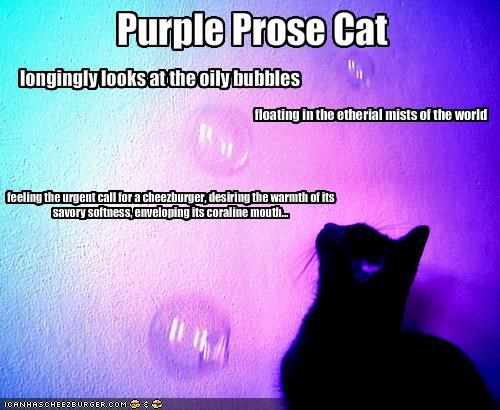Composition of the Amethystine Variety and Why One Must Abstain From Its Application (or “Purple Prose and Why You Should Avoid It”)
I’m polymerized tree sap and you’re an inorganic adhesive, so whatever verbal projectile you launch in my direction is reflected off of me, returns on its original trajectory, and adheres to you.
– Dr. Sheldon Cooper, The Big Bang Theory (Season 1, Episode 13 – The Bat Jar Conjecture)
Fans of the comedy TV series The Big Bang Theory likely remember this quote from the Physics Bowl episode, when Sheldon reacts to an insult from fellow physicist Leslie Winkle by saying as condescendingly as possible that “he is rubber and she is glue”. However, the fact that he seems to go out of his way to use the most advanced vocabulary possible in his retort only adds to the hilarious running gag of Leslie always managing to beat her rival at a game of wits.
So what lesson should novice writers be learning from Sheldon’s backfired comment? That trying too hard to sound smart often has the opposite effect than what you might expect, that is, it hurts more than it helps.
What is this amethystine composition of which you speak?
Writing that is overly decorated with fancy words and elaborate details is known as “purple prose”. It’s an especially common practice among inexperienced writers, who often believe that to write a really good story (or improve upon an existing dull one), one needs to dress up the prose with as many big words as possible to make their work look sophisticated. Basically, beginners seem to have this grand illusion that great literature is that which stands above the level of everyday speech.

Purple prose: Contemplate this exquisite aubergine blossom of the Rosaceae family
Everyday speech: Look at this beautiful purple rose
But here’s the problem with that logic: everyday speech is the level where most readers are, and more importantly, where they want to stay. Readers today don’t want to bore their way through long descriptions or have to pause at every other page to look up half the words they just read in the dictionary. They want writing that’s simple, that they can understand and find relatable, similar to the language they use themselves in the real world.
So I’ve been writing erroneously… I mean, wrong all this time?
Calm down, and take a second to note that I said “similar to”, not “the same as”. It’s OK to use some higher-level vocabulary and detailed narration in your stories, for when done in moderation and in tone with the style of the work, these can actually add to the quality of your writing. The danger is using these tools in excess, because after you’ve passed a certain point in flowering up your prose, these details will begin to draw attention to themselves and away from the flow of your story. To sum up, a little is fine, but too much is bad. Write with caution.
Now before anyone accuses me of hypocrisy, allow me the chance to admit to this embarrassing fact: I am guilty of writing purple prose. Even if I don’t always choose the fanciest synonyms I can find to replace everyday words, I love decorating my writing with adjectives and adverbs, and I tend to use intermediate-level words where common ones would work just fine. That being said, I used to be much worse. When I first started writing, I had this idea that nobody would want to read stories written in the plain language of a ten-year-old, so even though I was already well-read for my age, I went out of my way to find “bigger and better” words for my fiction. It wasn’t until I started learning about common writing mistakes as a young adult that I realized how flowery my early writing was, and I’ve since been gradually cutting the bad habits of my childhood. So take it from a writer who’s still breaking out of the novice phase: tone down the purple and focus on writing simple prose. Your readers will appreciate it.
 It’s worth noting at this point that as strongly as most experienced writers will argue against this practice, prose style is and always will be subjective. It’s entirely possible for a writer to not only be aware they write such elaborate prose, but actually do it on purpose. So if you’re a beginning writer guilty of this trope, don’t feel bad right off the bat. Maybe your goal is to imitate the exact styles of writers like William Shakespeare, Charles Dickens and Jane Austen, and that’s fine. Just know that unless you’re going for satire, most of the audience who would take your work seriously has probably been dead for a few hundred years.
It’s worth noting at this point that as strongly as most experienced writers will argue against this practice, prose style is and always will be subjective. It’s entirely possible for a writer to not only be aware they write such elaborate prose, but actually do it on purpose. So if you’re a beginning writer guilty of this trope, don’t feel bad right off the bat. Maybe your goal is to imitate the exact styles of writers like William Shakespeare, Charles Dickens and Jane Austen, and that’s fine. Just know that unless you’re going for satire, most of the audience who would take your work seriously has probably been dead for a few hundred years.
But I want to be taken seriously today! What should I do?
Don’t worry, the “purple prose bug” is treatable! For those of you aspiring writers who wish to establish yourselves before you try to follow the great authors who bend the rules, here’s a quick list of common purple prose mistakes and how you can avoid them:
1) Excessive detail. Yes, describing the setting of a scene before the action starts is often essential to telling a good story, but please don’t go on for a dozen pages about the hundred different colors in the sky or the history hidden in every brick of every building. Just because authors like J.R.R. Tolkien and Victor Hugo could get away with it doesn’t mean you can. One paragraph should be enough to set your scene, but no more than two.
2) Overly decorated nouns and verbs. If you’re one of the millions of readers who have read all of J.K. Rowling’s Harry Potter books, you may have learned that nouns and verbs should almost always include a “modifying friend”. But Rowling is an exception, a world-famous author of one of the best-selling book series in history, which you are (probably) not. That means she can do whatever she wants with her writing, whereas you should practice creating basic prose before you work too hard to copy her style. Try not to use too many adjectives and adverbs in your writing. Though this may seem counterintuitive, many famous writers would agree that less is more. If you don’t believe so, read a story by Ernest Hemingway or Mark Twain, and you’ll see how writing can be great without the need for too many “attachments”. To quote Twain, “When you catch an adjective, kill it.”
3) Said bookisms. This is one of the most common mistakes made by beginning writers: the constant use of alternative verbs for the word “said”. There’s a general belief that when it comes to writing dialogue, “said” is too plain and overused, so writers should go out of their way to replace it with words like “asked”, “muttered”, “hissed”, etc. As a teenager, I used a lot of these in my writing; I wouldn’t be surprised if I read back a dialogue-heavy scene from one of my old stories and found at least three pages between consecutive uses of “said”. But even famous authors seem to be guilty of this sometimes (I’m given to understand there’s an entire blog devoted to poking fun at the purpleness of Stephenie Meyer’s Twilight series), so don’t feel too bad if you find your own writing full of these bookisms. The important thing is that you know you should fix them. Dialogue should convey tone by itself, no extra tags required.
4) Too much “fancy vocabulary”. Continuing from the example of “said”, some writers tend to try and find as many advanced-sounding synonyms as possible to substitute the common words in their stories. While this may be fine once in a while, you shouldn’t run to the thesaurus for every other word you want to write. Otherwise, you’ll end up sending your readers to the dictionary just as frequently. It’s great to learn new words, but think about it for a second: the more time you put into driving your audience to read another book, the less time they’ll spend reading yours. Try to stick to vocabulary that your readers will understand, and if you must throw in a higher-level word now and then, at least have the courtesy to make its definition clear in context.
5) Exaggerated sentiment. There isn’t a lot I can say here except that this is pretty much a writer’s attempt to manipulate the reader into reacting a certain way to their writing. Going back to the first item on the list, if you throw too much rhetorical writing into your stories, it comes across as you trying too hard to evoke specific emotions from your readers, which more often than not will have the opposite effect. Trust your audience to understand what you’re trying to tell them. If you write it plainly enough, they will feel it.
Purple prose is a dangerous habit of many writers, and while it may be OK for some, most should make a point of avoiding or overcoming it, no matter how difficult this seems. If nothing else, choosing to create simple and clean prose is a sign of respect to your work and your readers, so take care with your style of writing. I’m certainly still trying.
So what are your experiences with purple prose? Have you read stories that you found too flowery for your taste? Were you (or are you) ever guilty of making these mistakes yourself?


Recent Comments